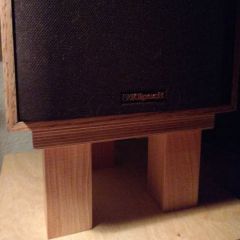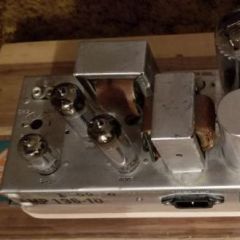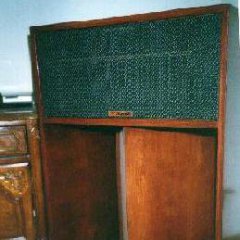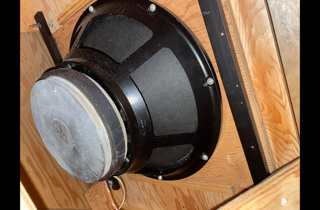-
Posts
1290 -
Joined
-
Last visited
-
Days Won
1
KT88 last won the day on November 3 2023
KT88 had the most liked content!
Profile Information
-
Location
Cologne, Germany
Recent Profile Visitors
3912 profile views
KT88's Achievements

Forum Veteran (4/9)
1.1k
Reputation
-
Yes, I was very impressed... by what I heard and how it sounds compared to my old 1977 Lascala, which has original components but very little sanded side walls (I could still kill the carpenter for what he did 18 years ago without asking. In the fall, I will have the LaScala's cabinet reworked, and the side wall will be reinforced with additional veneer). But now I come to the AL5 that I heard in the home of @Flevoman. I would like to say in advance that it is my very personal impression of the sound, which should not be generalized under any circumstances. That makes it easier for me to speak freely. This is the very first impression, after different songs and for the first time ever in an unfamiliar room. The AL5s sound incredibly homogeneous and natural. I was absolutely positively impressed by the seamlessness of the sound and the fusion of bass, midrange and treble. In addition, a very pleasant and extremely sympathetic basic tonality was lresented. A little on the warm side of things (which makes the sound very inviting), but without any annoying coloration in the mid band. The big challenge was achieved, tone colors but no coloration, that was a very positive first impression of my short listening experience. I somehow immediately took the AL5 to my heart. This harmonized with the beautiful appearance of these speakers. Flevoman has a fairly large living room as a listening room, the speakers are placed in front of the long wall (which I found very pleasant, except for one point that I will come back to later). Visually, they are perfectly integrated into his room. My old speakers look much bigger in our living room. Actually, the living room areas are quite similar, but because we have an even if a wide passageway at home, so our living room is effectively divided in two and I can only use half the space. That's why it looks optically very integrated at Flevoman's (similar to the original advertising images for the AL5 on the Klipsch website) At our place it looks as if I had put two washing machines in the living room and painted them light brown. The visual difference depending on the size of the room is that dramatic. I am not taking into account that the AL5 are actually even noticeably larger than the vintage LS. Now it is my impression that a very wide rear wall, as with Melvin, also means that the sound is very free of reflections on the sides. I am particularly thinking of the mids and treble. However, I feel very comfortable with a few of such reflections on the closer side walls, as they are at home with us. It reinforces my subjective impression of spatial listening because direct sound is enriched with relatively timely smaller amount of indirect sound. But I have a meter of distance to the side walls at home, because if the reflections are too close, it primarily means unpleasant colorations, so I mean indirect sound, which the brain can learn to distinguish if the delay time remains long enough. I hope it makes sense as it translates into English. So I am very curious to see how the AL5 would sound at our home. I was extremely curious before the listening session to see how Roy's still relatively young new tweeter horn would fit into the LaScala sound. Because the T35 (in my case alnico, fortunately) is in my view the great contentious, relevant and ambivalent aspect of vintage LS and Khorns (I'll write something about vintage Khorn in a few weeks because I'm still in the adaptation and a little restore phase with my 1973 Khorns, which are new to me. Just so you know, I'm delighted with these Khorns, the first in my life). The T35 (or K77) is very noticeable in its importance for the Klipsch sound... when it is gone you will miss it. I tried a CT125 17 years ago. It was one of the reasons why my LS disappeared into my (very good climatically) storage room for almost 5 years. When I rebuilt the LS, I remembered the original tweeter and the original AA crossover (I had bought ALK universal in 2006 and it was a musical step backwards for my ears, towards lifelessness). It's hard to describe what the K77 does for the overall sound of a vintage Klipsch LS or Khorn, the punch, the liveliness, the sense of authority, the great attack when plucking the strings of a Martin D28... it was back due to the reinstallation of my K77, and with it my enthusiasm and joy of listening was also back again. I suspect that some third-party tweeter manufacturers made the mistake of making their tweeters too gentle and tame. It's also called hi-fi or audiophile. At least with the CT125, everything was polished to a shine and the speech intelligibility was no longer good. I know that the CT125 is a bit quieter than a K77, but that really wasn't the only reason for my impression. There are certainly better third party solutions than the CT125 and I don't want to offend anyone. Well... how did Roy solve the weak points of the K77? Because on the negative side, many here know that the K77 can hiss, it can sometimes be annoying when it shouldn't be, and the K77 is, I mean this very seriously, very picky and moody when it comes to a piece of music. It's like a love-hate relationship. There are songs where I enjoy every note and life is beautiful. Then comes another song and somehow the K77 “manages” to make a Strat with intermediate pick-up positioning hit exactly the fried bacon resonance of the K77...OMG. To put it briefly and with the highest praise: Roy's new tweeter horn in the AL5 is like a K77 without the fried bacon sound but with the energy and liveliness of an original K77 plus more high end freq. That was my biggest surprise with the AL5. The whole is more than the sum of its parts. The new tweeter harmonizes with the exponential K401 and forms a joint team... even though it is a tractrix horn and perhaps radiates a touch wider than a K77. A perfectly solved task to mediate between the old world and the new world. That's why the AL5 sounds so wonderfully coherent to me after the first 30 minutes. There were aspects of the AL5 listening test that I didn't find quite so wonderful. But to say it in advance, and Flevoman may forgive me, it had more to do with his frontend than with the AL5. The bass was not as authoritative as I know it from my LaSala. Of course, there are physical limits to the low frequencies due to the short horn, but that's not what I'm talking about. I'm talking about the performance of the audible range. Personally, I definitely lacked punch and rhythmic timing. My foot remained motionless while listening. My expectations of 3D spatiality were not met at all. The sound remained on a two-dimensional line between the two speakers. It sounded, as they say, rather “shot in”. The front end was a Cambridge streamer, which I believe is a very good device for what it is. From there it went directly into a power amp (with type 45 output tubes of low wattage. Such an amp may promote a high-resolution sound in the treble but is not to my taste because I prefer powerful amps with punch in the bass and little interaction with the xover, such as my MC275). I read the brochure of the streamer. It is recommended for various configurations but expressly not for direct control and drive of a power amp. For this purpose, Cambridge has another more expensive model because it includes an additional real preamp stage - with buffer and impedance converter at the output. Melvin‘s streamer is technically more or less similar to my Bluesound node (I thin so). His Cambridge may be of higher quality but both have a volume function, but that doesn't make them preamps. I use the volume function when I'm lazy, but my Streamer goes into my C22CE, EAR 864 or Quad 34. I tried connecting my Node Streamer directly to one of my power amps and leaving out the preamp. It was the same anemic sound as with Melvin's system. There are two issues when you leave out the preamp. 1) As I said, there is no ability to drive a power amp properly due to too high output impedance. 2) You have to attenuate the line output of the streamer with its volume function. This results in an incredible loss of resolution, detail and spatial depth. This is because the digital attenuation of the signal in almost all such devices that do not have a built-in preamp stage is associated with a severe reduction in digital bandwidth. I tried it. If I turn the Bluesound Node down and turn up the preamp to compensate the SPL, the signal and the information content are much narrower and more boring than if I turn up the volume of the streamer (or even better, avoid the volume function and select the fixed voltage value at the output) and turn down the preamp accordingly. This effect has a very strong impact on the sound impression, even if the preamp already ensures the correct output impedance. This whole source/preamp topic comes in addition to the in my view somehow weak type 45 amp. Later I learned that Melvin also has a fully integrated very nice Melody tube amp with genuine preamp included and also with a volume control of course. But it was too late for a second listening to the AL5. To summarize, I can very well imagine the sound of the AL5 under optimal front-end conditions because I know my own LaScala inside out. Then the AL5 will have also the punch and the powerful, lively performance that my vintage LS can deliver. Except for the tweeter, the xover and the type of cabinet material, it is basically the same speaker in terms ofthe bass horn construction, the K33E, K55 (V or X). What should be less powerful and spatial in the AL5 compared to the vintage LS? I think the AL5 is in many ways even better than my vintage LS (although I don't question my LS and will never let them go). I am very impressed, emotionally when listening and rationally due to the technical engineering performance in integrating the new high-frequency horn. I wholeheartedly recommend the AL5 without reservation. Despite the adversities of the front end during the session, it was a rare and spontaneous positive impression that you don't often experience. I have since exchanged views with Flevoman about his frontend and I have written some very few lines from my point of view to him. In the end, it's all a matter of personal taste, but as far as the combination of streamer and poweramp is concerned, Flevoman is trying out other solutions, which I very much welcome and appreciate as it shows his flexibility and a genuine interest. In the end, he can decide for himself which frontend he likes best but then he knows about the alternatives. PS I have a small addendum for those who are aware of this point. I was very curious about how the AL5 is voiced. In my opinion, it is very similar to my 1977 LS in terms of voicing, with (!) the magnetic screw in the center of the small coil of the high-frequency section of the AA crossover. And that's what I like best.
-
Congratulations! I have 47 year old LaScalas which I like and two weeks ago I heard AL5 for the first time. I thought the sound was very good. You will have a lot of fun with it. To my ears, the sound is wonderfully round and not boomy as can be the case with the old LS. (I can do something about that if I have time). The AL5s also look great. Pics and impressions please later on.
-
Yes, the new Tannoy. This one in the link is like my Canterbury 15 but neodymium and not alnico which does not mean worse or better but different. https://www.fyneaudio.com/product/vintage-fifteen/
-
This is the Klipsch forum, perhaps the wrong place for other brands. But I would like to say one thing. Not only Paul Mills has left Tannoy but the whole management and technical team. I would never buy an expensive Tannoy Alnico again today. Behringer bought Tannoy maybe 10 years ago. Nobody knows exactly where the Prestige series is made today, they don't talk about it, some say in China. The Scottish Tannoy factory no longer exists and innovation and R&D have absolutely disappeared. I would only buy a Tannoy Prestige series used and preferably 15 years old to be sure. I haven't heard the Fyne speaker yet, but it's a nice story, all the founders of Fyne were over 60 years old in 2017 and left Tannoy altogether. They let make the cabinets in Poland which must not be bad. The prices are comparable (expensive) to the Tannoy Prestige series. So far you can believe a salesman...see the pic (Kevin from upscale).
-
To be honest, I can hear the difference in which type of cable, plug or other connection is used. Depending on the speaker, I can also clearly hear whether I plug the cables into the treble or bass input. When I made a few tweaks to my 1993 Tannoy Canterbury six months ago, I also addressed this issue because it just annoyed me that it always sounds different depending on how you do it. So I thought, since I'm not going to do bi amping or bi wiring, maybe it would be best if I avoided it at all. M.a.W. the best possible result without spending money on space rocket jumpers. This is what it looks like inside the Canterbury speaker now. As I had hoped, it clearly brings the best sound without any preference for mids, lows or highs. Just get rid of what I don't need. So I put bass and treble on just one plug.
-
I am reopening this thread to make it easier to find if anyone has a search about the K33V woofer. As I wrote earlier I bought 1973 Khorns where everything is very original and unmodified. However, I had to open one of the woofer chambers immediately after purchase because one of the voice coils was scratching very badly. As far as the purchase of the Khorns is concerned, it is not a problem because the price was really fair by European standards. The only problem was that the woofer was labeled K33V and I had never seen such a woofer in a LaScala or a Khorn. A search here in the forum revealed that in older threads the authenticity of this woofer as an original used part was partly doubted. After all, there is not a single reference to a K33V woofer in the historical timeline for the Khorn if you look there (can be found here in the forum). I was a bit confused, had the first owner of my new 1973 Khorns perhaps received replacement drivers at some point, or was there another way of replacing them? After all, the Khorn is absolutely genuine Klipsch from head to toe. I got the tip to ask Jim Hunter @JRH. His answer is very insightful, and who should know better than him: "I believe this is an EV version used only briefly. The P was CTS at Paducah, Ky. Later the B was CTS when they moved to Brownsville, TX." In fact, it's an early WK EV15B exactly the same as the one in this ad: https://reverb.com/item/79863104-klipsch-electro-voice-wk-ev15b-ev-15b-k33v-k-33-v-1970s-black Only, my woofer is missing the marking on the magnet, the one in the reverb ad has a number. But it's the same woofer, even the number on the cone is the same. I wanted to clarify this so that people with a LaScala, Cornwalls or Khorns from around 1973 are not confused when they see a K33V driver in their speaker. Why there are only very few Klipsch speakers with K33V may be speculation today. It seems to have been more of a test balloon. Anything is possible, from the cost of purchase to the fit of the specification to the observed reliability. I will not have the K33V reconed. I have read in guitar forums that the old EV SRO and EV15B may well have problems with the voice coils (like my Khorn as well). Since I have temporarily installed the original 1977 K33E out of my vintage LaScala in the Khorn with great success soundwise, I will look for such K33E and eventually use them, whether vintage mint or new, but the real ones delivered via Klipsch themselves because I have already completed the phase of searching for replacement woofers. I don't want it to be a Crites or a China copy re this fine vintage Khorn. Here is another K55V, not mine, which has a number.
-

The absolute best amp you’ve heard driving heritage speakers.
KT88 replied to MJada's topic in 2-Channel Home Audio
Well, I am interested in the AHB2 because there is a certain relationship to my old British Quad amps. And then this Topping LA90 also comes into play. If I understand it correctly, it's very much about certain outstanding technical values such as the signal-to-noise ratio...or other parameters. The question of this thread is "the absolute best amp" to drive Heritage Klipsch. I would think you can't pin it down to specific technical excellence values. Personally, I would say I have to hear it and it has to reach my heart and gut feeling. When people say that the AHB2 is the amp that Peter Walker could only dream of...well I have amps that Peter designed. I wouldn't naively say that because AHB2 is newer and has better specs it necessarily sounds better when I add everything together I think the core question of the thread is on a deeper level because it's about the match with Klipsch heritage speakers where a good balance and dosage of many parameters is important. The heritage speakers are in some ways "easy" to feed and in other ways "difficult" to feed. In the end, personal taste is the most important thing. I wouldn't say that an amp suddenly appears that puts everything else in the shade. If it does, wonderful, I should be allowed to hear it. But all too often in the last 60 years we've seen a "one trick dog" being hyped in marketing. And then, a little later, the next one is brought in. My conclusion: no aversion to innovation, but never throw the baby out with the bathwater when it comes to existing good-sounding amps. I would love to hear an AHB2 but I would also love to hear a Pass first watt. In the meantime, I'm very happy with my old Quad 606, 306 and also with the MC275. To sum up, I'm open to new things but I'm very happy with what I have. If something new makes everything a little better then the question remains, is it a new listening experience or a marginal feature that I quickly get used to and what is assimilated by my hearing quickly. Then it's not worth it. I'll go further and it gets a bit philosophical. If the new stuff is actually better, ok, my 40 year old alter ego might aspire to that. The 65-year-old Heinz is perhaps happy with what he has and knows because the time of hunting is over. That's not meant to sound boring and depressing, but relaxed and sitting in the saddle. -

The absolute best amp you’ve heard driving heritage speakers.
KT88 replied to MJada's topic in 2-Channel Home Audio
I am not primarily interested in being able to carry out repairs myself. I'm happy to leave that to the trained specialists. However, in the future, say 20 years from now, it will be an invaluable advantage to have an exact circuit diagram in case the company no longer exists...which can always happen in this business. I'm interested in knowing that it is public how exactly the circuit works in the amp and how it functions. Not that I personally would understand everything but it would give me more confidence to buy an expensive product if it is not a black box and a third experts party would be able to fix it. -

The absolute best amp you’ve heard driving heritage speakers.
KT88 replied to MJada's topic in 2-Channel Home Audio
Back in the 1970s, Peter Walker's current dumping circuit was immediately made available to the public. The service manual for the various Quad amps was and still is an open source regarding the circuit, the components used and their electrical values. How is it today? What exactly did THX develop? Is it anonymous or are there specific people or a team behind it? I assume that the AHB2 is a pure licensed product? So is the circuitry in the AHB2 being shrouded in secrecy by THX or can you see everything you should (for repairs etc.) in the service manual? -

The absolute best amp you’ve heard driving heritage speakers.
KT88 replied to MJada's topic in 2-Channel Home Audio
I use Quad tube and sand amps since 45 years among other amps with joy. The concept of the AHB2 with its feed-forward error correction really reminds me on the Quad e.g. 606 power amp from the days. https://www.audiosciencereview.com/forum/index.php?threads/review-and-measurements-of-benchmark-ahb2-amp.7628/page-140#post-1026597 https://www.meridian-audio.info/public/quad_405_test_reports[2314].pdf If you read the AHB2 description under „technology“ I think they have made a modern version of the Quad amp current dumping circuit. https://benchmarkmedia.com/products/benchmark-ahb2-power-amplifier -

The absolute best amp you’ve heard driving heritage speakers.
KT88 replied to MJada's topic in 2-Channel Home Audio
Unfortunately, there is no clear "technical" answer to this question. It has a lot to do with taste and personal preferences. Because the Heritage speakers are so efficient, some people like the advantages of the small SET amps, holographic sound, etc. Others like a solid sound with reserves and authority in the sound image. Then there is the question of which of the two concepts is fatigue-free listening in the long term. Then there is the question of whether a small SET should feed a bass horn or has to feed a large bass reflex speaker. Personally, I'm more in the camp of the solid sound image with dynamic reserves. A very classic combination is, for example, a Klipschorn with Mcintosh tubes. I like it best with my C22CE and MC275Mk4. But my older sand Quad34 with Quad 606 also sound very nice. From time to time I use a 300B SET or one of my friend's home-made 6L6 SETs with 3 watts, I think. But these are always just short excursions while I'm already looking forward to what I perceive as the "real" powerful sound. -
Were you able to hear the Heresys in its original state before you made all the changes? Did it "actually" sound good or was there a significant lack of sound? I am not sure if you understand the post of Deang. He makes repairs of such xovers and other stuff and is the approved Klipsch vintage speaker/xover restorer.
-

How to purchase new woofers for 1987 Klipschorns
KT88 replied to RickD's topic in 2-Channel Home Audio
Because it is accurate I would compare the DC resistance of both woofers, measuring the woofers without connection to the xover. Others are the experts but a 4 ohms Z of a woofer should measure below 4 ohms DC resistance if the voice coil is ok. -

How to purchase new woofers for 1987 Klipschorns
KT88 replied to RickD's topic in 2-Channel Home Audio
That is a pleasant discovery. I would also measure the DC resistance of the other woofer to make sure that everything is ok. I don't know what woofers were installed in 1987. But I would have expected you to measure approx. 3.3 ohm DC with an impedance of 4 ohm provided that the xover is not connected. But the good thing is that you obviously don't have to replace or repair anything. -

How to purchase new woofers for 1987 Klipschorns
KT88 replied to RickD's topic in 2-Channel Home Audio
I'm impressed and I think it's cool what energy and expertise people like John Warren put into his research and testing. Because it's very refreshing that there are people who get to the bottom of things physically without getting lost in numbers and ignoring the emotional and personal hearing. I find that remarkable. In the case of this Sq. vs. Rd. magnet comparison, I have to be honest and say that I think it's very likely that I would enjoy both types of K33.
















